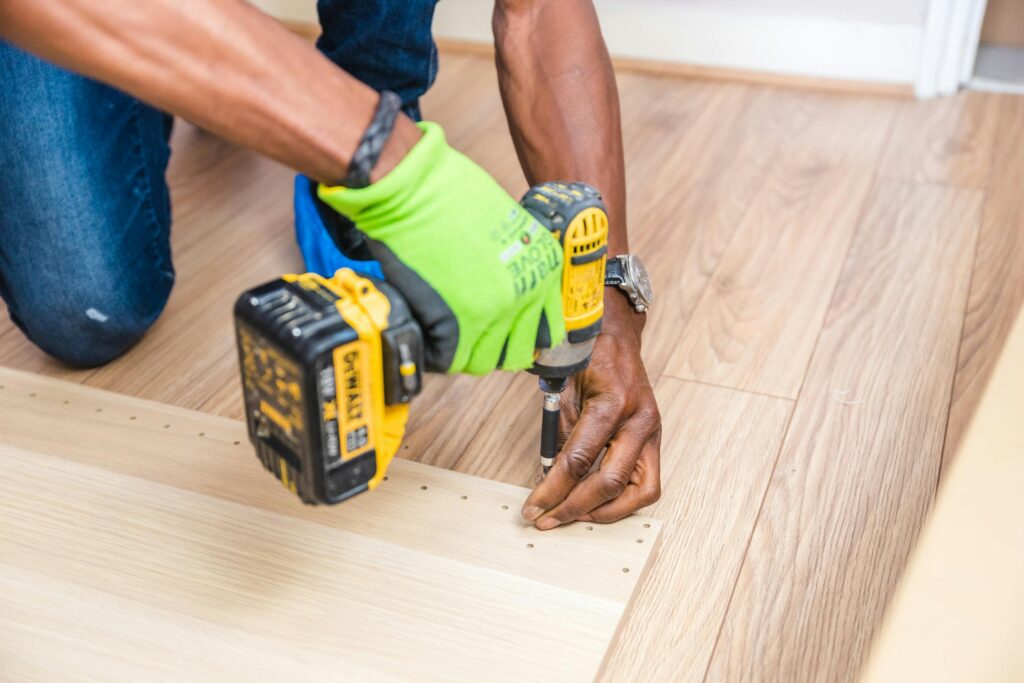Last Updated on June 19, 2024 by John Coleman

Introduction
Recently, I was going through my usual process of planning a DIY project for my house. As I listed all of the items I would need, I was simultaneously making mental notes of how I might get each item needed at the lowest price possible. It was during this process that the subject of this blog post came to me and I felt that I should share the information with any and everyone it might benefit. Whether you are a beginner or an experienced DIYer, these cost-saving strategies I’m sharing will likely be very helpful. I have organized a list of the cost-reduction ideas I use and turned it into this “Guide to Cost-Saving Ideas for DIY Projects”. At the end, I will give you a scenario showing how some of these methods work. I hope this post helps you organize and save money to put towards even more DIY projects!!
What is DIY?
DIY stands for “Do It Yourself” and refers to any project that you undertake yourself instead of hiring a professional. DIY projects can range from simple home repairs and improvements to crafting, woodworking, and even building furniture or structures. Keep in mind that DIY is not an “all or none approach”. There may be some parts of a project that you don’t feel comfortable doing such as plumbing and electrical work. It is perfectly fine to hire out that part of the project. It is still considered a DIY project because, overall, you still save money by doing parts of the job yourself for which you do not have to pay labor costs which is the main appeal of DIY. The other perks of DIY are the satisfaction and sense of accomplishment that comes with completing a project on your own. However, DIY projects can also be costly if you are not careful and do not plan properly. That’s where these cost-saving ideas come in handy.
Does DIY Really Save Money?
The short answer is, yes. DIY projects can save you a significant amount of money compared to hiring a professional to do the same job. According to Angi.com, “62% of homeowners take on DIY projects to save money”. However, this also depends on the type and size of the project you are looking to take on. Some projects may require special tools or materials that can add up in costs. It’s important to carefully consider these factors before deciding if a DIY project is truly cost-effective for you. In general, the more skills and knowledge you have in a certain area, the more money you will save on DIY projects. That’s because you won’t need to hire someone else to do it for you and can confidently complete the project yourself.
If you purchase through links on this site, we may earn a small commission. See our affiliate disclosure.
My List of Cost-Saving Ideas for DIY Projects
It Starts with Project Ideas
Most DIY projects start with a problem that you want to solve. This is where ideas and visualizations begin to churn. Take a look at what you want to fix, upgrade, or change altogether, and search online for information and pictures for ideas. It is also helpful to look up the average costs of the project you are planning. This will give you insight into whether the project will need to be done in sections to accommodate your budget or if the job fits your budget and can be accomplished all at once. During this process, I always like to bookmark websites that are helpful and put all the bookmarks under one category (i.e. patio layout ideas or outdoor kitchen ideas) in my browser bookmarks. This will help when you want to quickly reference the research you have done. Now that you have ideas, you want to think about what steps are involved in the process to get this job done. You will now want to grab a notepad and pencil and jot down the steps you have identified.
Online Tutorials
Now that you have a general list of steps to complete your project. It’s time to dig a little deeper. You now need to:
- Look up specific tutorials (videos, blogs, etc.) about your project to see if there are any steps you may have overlooked, and add them to the list of steps you have already identified.
- Review your list.
- Mark any step(s) that you are not familiar with performing and research it further. If you find a step that you know you are not comfortable performing, clearly mark it as you may have to reach out to someone with expertise in the area to give you tips and pointers or possibly contract someone to perform that particular step.
(Note: Attempting to perform a task that you do not completely understand could result in damage or an error that could cost you more than if you had just hired someone to do it.)
How a Written Plan Will Save You Money
Having a step-by-step plan is very important because it will save you time and money. A step-by-step plan will help you control the overall costs of the project. If you know what you need for each step, you can gauge the cost for each step of the plan which creates precision in cost tracking throughout the project.
You now have an idea of how you want your project to look at completion and an outline of the steps to get the job completed. Now it is time to start putting it all together and finalizing the plan. I recommend writing your list in pencil so you can modify it.
Take a look at each step that you have identified and note all items, materials, and tools you will need to complete each step. You can now begin your search for cost savings.
Here Is My List Of Cost-Saving Ideas For DIY Projects
Tools
Most projects are going to require basic DIY tools such as a flat head or Phillips head screwdriver, pliers, hammer, etc. However, some jobs require larger tools or even specialty tools. Don’t go out and buy these tools. Instead, try these options:
Ask your neighbor or a friend – they may own the tool and be willing to lend or rent it to you. (Important: Please be sure to return the tool immediately after you use it. I can’t tell you how many tools I have loaned out that I didn’t get back.)
Check with a local rental company – These companies usually rent by the day or even half a day.
(Tip: If you need the tool for more than a day, rent the tool around noon on a Saturday for one day. Many rental companies are not open on Sundays so you are not expected to return the tool until Monday morning. This will give you a little extra time to use the tool but at a daily rate. You can check with the company to see what their policies are. This may not apply to all rental companies.)

Hardware Store Loan Programs – Some hardware stores have a tool loan program. These programs require you to put a deposit down to borrow the tool. Then, when you return it (and it isn’t damaged), they give your money back. I like this method because it doesn’t cost you anything.
You have your list of tools and how/where you are going to get them, write them on your plan under the step for which they will be used, and let’s move on.
It’s time to think about materials, parts, etc.
Material Reuse/Upcycling
Take a look around your garage, house, attic, and property. Are there any items you have that can be reused or repurposed? This can be anything from 2x4s to sinks or old countertops. You may have to invest a little work in these items to get them presentable but it will save you money and also free up space around your home.
Thrifting
This is an area that can be very exciting as you never know what you are going to find in a thrift store. Sometimes you can run across awesome deals on items that either fit your project perfectly or are very close to what you are working for. Another plus to thrifting is that some thrift stores are non-profit so the proceeds go to local charities or organizations to help those in need. How awesome to contribute to helping others while you are completing a DIY project?
Community Resources
If you look closely enough you are likely to find community resources available that you didn’t know existed. For example, I ran across a place that offered after-school services such as tutoring. One of the ways it was funded was by thrifting leftover construction supplies donated by local contractors. Whenever the contractors completed a job and had materials left (such as wood, sheetrock, sinks, duct work, countertops, etc.) they would just donate it to this organization. Then, various handymen/handywomen and DIYers would come and purchase the supplies at a discounted price and the proceeds went to the organization. Finding these types of resources is just another way to contribute to your community while you DIY.
Compare Prices
Don’t just settle for the first price you see on an item. If you are planning to purchase new materials or supplies, shop around and compare prices at different locations. You may find a better deal at a local hardware store compared to a big-box retailer, or vice versa. If it is a local store, you will likely have to go to the physical locations to see what they have to offer. However, for the larger retailers, I prefer to look online because they typically have a larger online selection as well as deals that aren’t advertised in the store. Again, you can make a bookmark tab in your browser and save the pages for the products that you like. Additionally, keep an eye out for sales and clearance items, as these can often save you a significant amount of money.
Discount Stores
I know this sounds like a very general heading but there are stores out there that specifically carry discounted items that have minor flaws. I have a few of these stores in my area that are geared toward discount appliances. In these stores, you can find items such as refrigerators, grills, etc. that might have a small ding or scratch on them and are sold at significant discounts because of the flaws. Sometimes the imperfection will be on the backside of the item where you can’t even see it while other blemishes can be easily fixed with minimal effort. This can be a huge money saver; especially on larger items. Significant to note, that you should always check with the store and verify what their return policy is as well as if the item comes with a warrant. These products may not come with a warrant or the stores may not have a very reassuring return policy. To give you peace of mind, you can always ask that the product be plugged in to verify that it works before purchasing.
Bulk, Bundle, or All-Inclusive Prices
When purchasing items that you know you will use in the future, it is often more cost-effective to buy in bulk or bundles. For example, if you are planning on doing multiple DIY projects that require paint, consider buying a large bucket of paint instead of individual cans. In many cases, you will use the same color paint on multiple spots; especially if you are working in the same room. Another example would be if you were converting to recessed lighting. It will be cheaper to buy the lights in bulk rather than individually. In both scenarios, this can save money compared to buying each item separately.
All-inclusive prices are not always easy to find, but they do exist. Lately, I have been putting together a lot of content about outdoor kitchens which are not cheap projects. Some of the main items in an outdoor kitchen are the island, grill, sinks, and storage. I searched and found a website that designs all-inclusive custom outdoor kitchen islands that can be installed DIY. These islands can be built to include a grill, a sink, storage, etc. When you look at the price of each of these items included plus what the island would cost, it’s a good deal. It also saves you time by eliminating the task of having to search and compare prices. Sometimes saving time is saving money too!
Social Media Markets/Apps
Social media markets and trading apps are a very popular way of finding second-hand items for reasonable prices. Some examples of these would be Facebook Marketplace, Craigslist, and Offerup. These platforms often allow individuals to sell items they no longer need, eliminating the need for middlemen and potentially lowering prices. It’s also a great way to find unique or rare items that you may not be able to find elsewhere. In addition, social media markets and trading apps can also be used as a way to trade or exchange items with others. This is especially useful for items that may not have a high resale value but are still in good condition and can be useful to someone else.

Discounts/Coupons
Another way to save money on purchases is by taking advantage of discounts and coupons. Many stores and online retailers offer discounts or coupons for first-time buyers, loyalty rewards, or holiday sales. It’s always a good idea to do some research before purchasing to see if there are any current discounts or coupons available. Some websites and apps also specialize in collecting and sharing discount codes for various retailers, making it easier to find savings. Examples of these sites would be Coupon Cabin and RetailMeNot. Additionally, signing up for email newsletters or following social media accounts of your favorite stores can also provide access to exclusive discounts and promotions. Don’t forget to check each website/app as they do not all carry the same discount. One may have a better discount than another.
Military/Veteran Discounts
If you are a current or former member of the military, there may be discounts available for you at certain retailers, so it’s always worth asking if they have a military discount. Be sure to bring your military ID or proof of service when taking advantage of these discounts.
Money Saving/Cash Back Apps
In today’s digital age, there are many apps and websites that can help you save money or earn cash back on your purchases. These apps often include features such as coupons, price comparison tools, and cash-back rewards for using their platform to make purchases. Some popular examples of these types of apps include Ibotta, Rakuten (formerly known as Ebates), and Honey. I frequently use these types of apps. You would be surprised at how much money you can save over time just by buying through apps like these.
Other types of cash-back apps allow you to scan receipts for points that you can redeem for gift cards or cash. If you have multiple apps that allow you to scan receipts, you can scan the same receipt to each app for points or cash. Yes, it’s time-consuming but it is still money back.
Though it is not an app that you would likely use to buy items for a DIY project, I would like to recommend trying out the Upside app. This app provides money back at participating gas stations, convenience stores, and restaurants. This is just something I wanted to throw in because almost all of us make these types of purchases daily.
Credit Cards with Cash Back or Reward Points
Using a credit card that offers perks or reward points for purchases is a great way to save money or gain points that you can apply to save on other purchases in your life. These types of credit cards often offer cash back, travel rewards, or other benefits for spending at certain stores or categories. Do your research to find the best card for your spending habits and needs. For instance, if you travel, you might want a card that gives you travel points or air miles for plane tickets. Or you might just want the good old-fashioned cash back 🙂
I want to stress that if you use this method to save money and gain perks, you must practice extreme discipline and be responsible by not spending outside your budget. It’s important to pay off your balance in full each month to avoid interest charges. Remember, your goal is to save money, not go into unnecessary debt.
Loyalty Programs
Retailers frequently offer loyalty programs that can help you save money on future purchases. These programs often involve earning points or rewards for each purchase made at the store, which can then be redeemed for discounts or free items. Be sure to sign up for these programs if you frequent particular stores regularly.
Membership Programs
Membership programs come with benefits such as exclusive discounts, free shipping, or early access to sales. These programs often require an annual fee but can be worth it if you shop at the store frequently. Some popular membership programs include Amazon Prime, Costco, and Sam’s Club. Consider your shopping habits and calculate whether the benefits of a membership program outweigh the cost.
Sale, Repurpose, or Refurbish Items
I like to use this method if I am renovating a space or upgrading items in an area. Let’s say you are renovating your bathroom. If upgrade your sink, fixtures, toilet, etc., don’t just throw it away. Post it on marketplaces and sell them. There is likely someone who is looking for the very items you post.
Also, instead of buying all new items, consider repurposing or refurbishing items that are still in good condition. This can save you a significant amount of money and also give your space a unique touch.
Let’s Put Some of This Together in a Scenario
For demonstration purposes, I am only going to use the methods that I can put a percentage on because there is no way for me to gauge how much you could save with a method such as thrifting.
Let’s say you have decided to buy an item that costs $1000 and you apply just a few of the money-saving tactics previously described. First, you find a discount of 10 % on a cash-back app, you have a coupon for 10% off (or use your military discount of 10%), then you purchase the item through the cash-back app with a 3% cash-back credit card. That is a total of 23% in savings which saves you $230 on the $1000 item you purchased. You ended up only paying $770 for the item. See where these savings could add up quickly?
Keep in mind that it doesn’t always work out perfectly like this scenario. Some stores may not allow the use of multiple discounts during one transaction. However, even if you could only use the 10% off coupon and made the purchase with the 3% cash-back credit card, you would still save 13% ($130) and only pay $870 for the item.
(TIP: If you are purchasing more than one item and the store allows only one discount per transaction, you can always take a friend to the store with you, divide up your items and let your friend make a transaction as well. Voila! You just turned it into two separate transactions and you were able to use both discounts. Just be sure that you pair the best discount with the highest-priced item(s) to maximize the amount saved)

Conclusion
As you can see, there are numerous cost-saving ideas to save money when shopping for DIY projects. By utilizing discounts, coupons, and membership programs, you can accumulate significant savings over time. Remember to be mindful of your spending, research, and compare prices before making a purchase. Putting in a little effort and planning to become a savvy shopper will make your money go further. So next time you’re tempted to pay full price, consider the various money-saving strategies we discussed and see how much you can save. Who knows, your savings on one project may pay for your next project!
Frequently Asked Questions
What are some ways to save money on DIY projects?
DIY projects can be made more cost-effective by planning thoroughly, reusing supplies, taking advantage of sales at home improvement stores, and borrowing or renting tools instead of buying them. It’s also helpful to watch instructional videos or attend free workshops to learn how to do the project efficiently, reducing the risk of costly mistakes.
Can I combine various discounts, coupons, and cash-back offers when shopping?
Yes, in many cases, you can combine various discounts, coupons, and cash-back offers when shopping. However, it’s essential to review the specific terms and conditions of each offer, as some retailers may limit the use of multiple promotions on a single purchase. Always check the store’s policy or inquire with customer service to ensure the most effective use of your discounts.
What happens if a store doesn’t allow the use of multiple discounts?
If a store does not allow the use of multiple discounts, it means you must choose the most advantageous offer. For example, if you have a 10% off coupon and a $20 off coupon, and the store doesn’t allow you to use both, you’ll need to determine which one offers the greater savings for your purchase. In some cases, the store might automatically apply the best discount for you.
How can I be sure that I’m getting the best deal?
To ensure you’re getting the best deal, it’s advisable to do some research before making a purchase. Compare prices from different retailers, both online and in physical stores. Make sure to check if there are any discounts, coupons, or cash-back offers available. Using price comparison websites or apps can also be helpful. Don’t forget to factor in the cost of shipping if shopping online. Reading customer reviews can also give you insights into the value for money of the product. Ultimately, the best deal is not just about the lowest price but also about the best value for your money.
What should I keep in mind while planning for a purchase?
When planning for a purchase, it’s important to establish a clear budget and stick to it as best you can. Consider your financial situation and prioritize your needs over your wants. Research the product thoroughly before buying, ensuring that it meets your expectations and requirements. Keep an eye out for any upcoming sales or promotions that could help you save money. Don’t forget to check the product’s warranty or return policy, as this could save you from potential disappointment or financial loss in the future. Also, consider the lifespan and maintenance costs of the product. Most importantly, make an informed decision and don’t rush into making a purchase.
How can my savings on one project be used in the future?
Savings from one project can be smartly leveraged for future use in a multitude of ways. This could serve as a financial cushion for other projects, helping to offset unexpected costs or allowing for higher-quality materials or services. Alternatively, these savings could be invested in expanding your business or in professional development opportunities, such as courses or conferences, which could lead to increased efficiency and profitability in the long run. It’s also worth considering setting these funds aside for maintenance, updates, or upgrades related to the original project. Finally, you could also use these savings as a contingency fund for any unforeseen circumstances in the future.
If you liked this article, you may also like:
How to Choose a Grill for Your Outdoor Kitchen: The Ultimate Buying Guide
A Guide to Design a Low-Budget DIY Outdoor Kitchen
If you purchase through links on this site, we may earn a small commission. See our affiliate disclosure.







